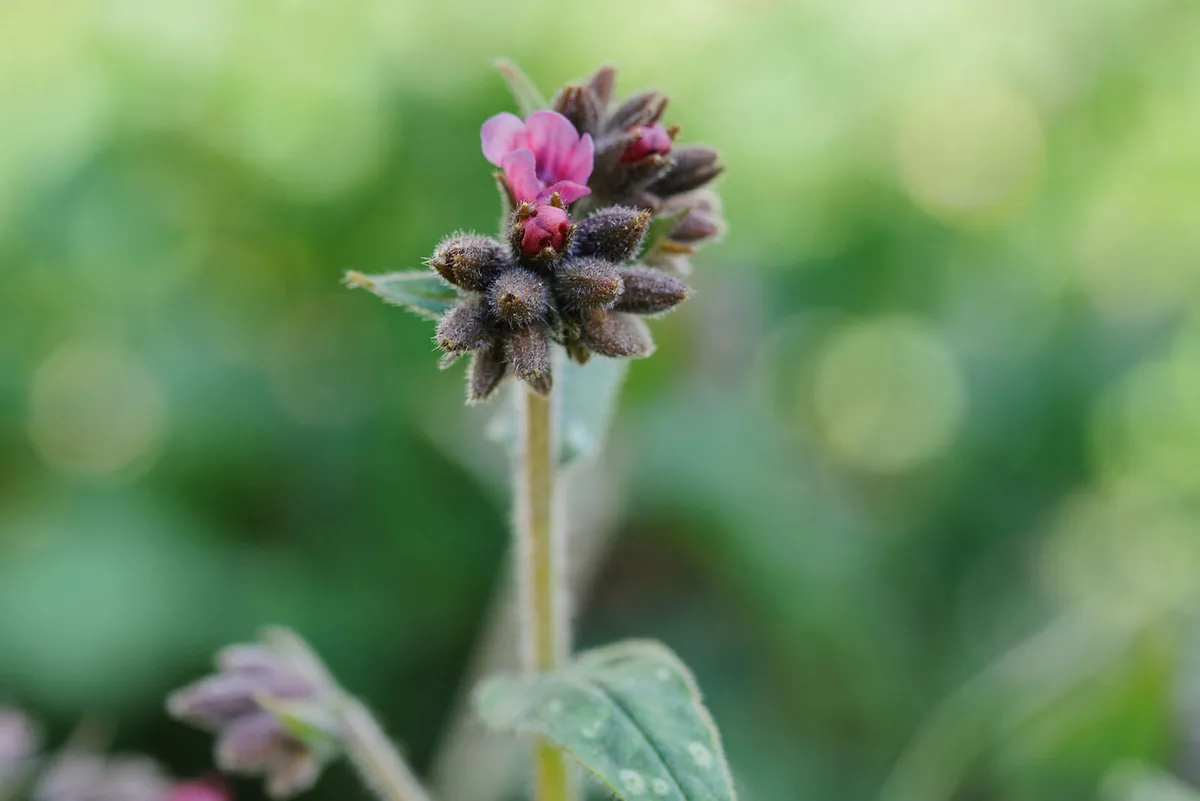For centuries, Pulmonaria was grown in gardens as a medicinal plant, as it was thought that an infusion of the leaves would act as a treatment for lung ailments.
They didn’t become widespread for ornamental use until the late, great gardener Margery Fish began enthusing about their virtues in her books based on the garden she created at East Lambrook Manor in Somerset, in the early 1960s. In Cottage Garden Flowers she records how welcome they are in the early spring garden ‘often rising above the snow and fluttering unconcernedly in the bitter winds of March’. In a later book Ground Cover Plants, she advises a practical use for the coral-flowered species: ‘P. rubra has luxuriant leaves and there will be no weeds where it grows’.
IN BRIEF
What Evergreen, semi-evergreen or deciduous herbaceous perennial members of the Boraginaceae family. Clump-forming or spreading to 30cm tall. The leaves vary from narrow and lance-shaped to heart-shaped, and the flowers are carried on short, usually unbranched, stems just above the foliage.
Origins Pulmonarias are widely distributed in Europe and western Asia in mountains and moist, shady places. The genus is composed of 18 species but only eight are known in cultivation.
Season Flowers appear at any time from late winter to mid spring, lasting in a few cases, until early summer. The ornamental leaves are a feature during the growing season or beyond in evergreen forms.
Hardiness Most are hardy down to -40ºC, with some tolerating -45ºC. Most suffer at temperatures above 20ºC.
Nectar-rich and appearing at a time of year when flowers are scarce, pulmonarias are very popular with bees. Their propensity to hybridise and self-seed freely has led to a host of cultivars appearing as chance seedlings in gardens and nurseries, including Pulmonaria ‘Barfield Regalia’, a large-leaved semi-evergreen, with violet blue to dark blue flowers.
Newer cultivars have arrived as a result of specific breeding programmes, particularly in the USA during the early part of this century. Plants are still being selected for their traditional virtues of flower colour, and leaf markings, but the spots and splashes have now extended to producing cultivars in a new style where the whole leaf is predominantly silvery-grey. This contrasts well with summer-flowering, shade-loving plants, such as herbaceous geraniums.
Pulmonarias also look wonderful planted with bergenias, such as ‘Overture’, which holds magenta flowers above scarlet stems in mid spring and the leaves of which turn dark claret in cold weather, or ‘Bressingham Ruby’, which boasts a fanfare of deep ruby leaves in winter, with crimson undersides, red stems and rose-pink flowers.
Pale-flowered and silver-leaved pulmonarias contrast well with dark-leaved heucheras, such as ‘Obsidian’ or they can break up the sultry forms of dark Helleborus x hybridus.
They also associate well with other dainty plants, including snowdrops, Ophiopogon planiscapus ‘Nigrescens’ and Cyclamen coum. The blue-flowered forms accentuate clear-yellows of Erythronium ‘Pagoda’ and Narcissus ‘Jetfire’. Plant those with silver foliage in bold associations with acid greens of early euphorbias, the pretty Bowles’s golden grass, Milium effusum ‘Aureum’, or at the base of dark tree trunks, such as the shiny mahogany Prunus serrula or the dark chocolate-coloured Prunus rufa. Paler flower colours are ideal for underplanting tulips or among the fresh green foliage of emerging ferns.
How to grow pulmonarias
Where to grow pulmonarias
Pulmonarias flourish in part shade in moisture-retentive but free-draining, humus-rich soil, although some are tolerant of sun, if they are given plenty of moisture.
How to care for pulmonarias
Lightly mulch in spring with well-rotted organic matter and deadhead immediately after flowering to prevent self-seeding. Clear dead foliage from deciduous forms in autumn, and tidy up evergreen cultivars in spring, cutting them hard back. Water and feed with a slow-release fertiliser and new foliage will rapidly emerge. Pulmonarias are generally short-lived, so to ensure longevity, clumps should be divided after flowering every three to five years. This is particularly true of the cultivar ‘Sissinghurst White’. Evergreens can become semi-evergreen in colder climates.
Pulmonaria problems
Powdery mildew is a problem in hot, dry conditions and the first sign that plants are unhappy. A greyish powdery coating appears on the upper and lower surface of the leaves and, in extreme cases, individual patches join together, coating the whole plant, weakening them to a point that growth and flowering are poor and they look unattractive. Be vigilant.
Take preventative action by watering well before the onset of drought, remove infected leaves immediately before the problem spreads, then boost growth by feeding with a dilute, high-potash fertiliser to toughen growth. If plants are badly affected, cut them back to the base, dispose of infected leaves away from the garden, water and new leaves will emerge later in the year. Some, especially more recent American introductions, are resistant to mildew, including ‘Apple Frost’, ‘Benediction’, ‘Cotton Cool’, ’Margery Fish’, ‘Milky Way’, ‘Raspberry Splash’, ‘Silver Bouquet’ and ‘Victorian Brooch’.
13 of the best pulmonarias to grow
Pulmonaria ‘Blue Ensign’

A vigorous cultivar with broad, dark leaves to 25cm long. The rich-blue to blue-violet flowers appear from mid to late spring, rivalling gentians for intensity. Discovered as a seedling at RHS Garden Wisley in the early 1990s. Excellent as ground cover. 30cm.
Pulmonaria ‘Cotton Cool’

A striking, semi-evergreen with long, narrow, tapered leaves that are held almost upright and are completely silver, although some have dark-green margins. One of the best for foliage, which is the perfect foil for the blue and pink flowers that appear from mid to late spring. Drought tolerant. 30cm.
Pulmonaria saccharata ‘Leopard’

Raised by plantsman Graham Stuart Thomas after it appeared in his garden in around 1970. The semi- evergreen foliage is dark green, so the silver and white markings are prominent. Flowers are reddish-pink fading to lavender. Vigorous and clump-forming, it is suitable for containers or borders. 50cm.
Pulmonaria ‘Benediction’

Forms clumps of lightly spotted, dark-green leaves. Loose heads of cobalt-blue flowers appear from late winter to mid spring and are among the deepest blue of any pulmonaria. An attractive, mildew-resistant, American selection; good for massed planting. 30cm
Pulmonaria ‘Silver Bouquet’

Creates a large clump of long, slender leaves, which are initially spotted, then age to silver. Clusters of large, bell-shaped flowers are held above the foliage on upright stems. These open pink and turn blue as they age. Introduced by Terra Nova Nurseries in Oregon. 30cm
Pulmonaria ‘Trevi Fountain’

Semi-evergreen with silver leaves and large, cobalt- blue flowers that age to pink and appear from mid to late spring. A hybrid cross between P. longifolia ‘Bertram Anderson’ and P.‘MargeryFish’ fromTerra Nova Nurseries in Oregon. 30cm.
Pulmonaria saccharata ‘Silverado’

Its large mounds of leaves, which stay throughout the growing season, are oval and silvery grey with a dark green border that’s splashed with silvery grey. Blue, pink and white flowers appear in early spring. Rust resistant, though this is rarely a major problem. 45cm.
Pulmonaria ‘Majesté’

A silver-leaved cultivar with pink flowers that turn blue, from late winter to early spring. Prefers shade but will tolerate sun provided there is adequate moisture. Found as a seedling near a clump of P.saccharata ‘Mrs Moon’ at Ferme Fleurie in France. 50cm.
Pulmonaria ‘Raspberry Splash’

A vigorous, hybrid between P. longifolia ‘Bertram Anderson’ and P. saccharata ‘Leopard’ with neat mounds of silver-spotted foliage, and masses of large, upward-facing, raspberry-coloured flowers that turn purple then blue. 30cm.
Pulmonaria rubra

A semi-evergreen, with hairy, pale-green foliage and coral-red flowers that appear from late winter or sometimes earlier. It prefers cool summers and dislikes drought. The leaves of cultivar ‘Bowles’s Red’ are lightly spotted and pale green. 50cm.
Pulmonaria ‘Little Star’

Low-growing, compact cultivar that forms clumps of short, narrow, lance- shaped leaves that are dark green, with a few, small, silvery spots. Masses of dusky pink buds open to bright, cobalt-blue flowers from late spring to early summer. 20cm.
Pulmonaria Opal ('Ocupol')

A semi-evergreen, compact cultivar, with pale-blue flowers opening from pale-pink buds from early spring to early summer. The narrow oval leaves, heavily blotched and speckled with silver, are ideal for lighting up shady spots. 30cm.
Pulmonaria ‘Sissinghurst White’

A refined evergreen with dainty flowers that appear in late winter or early spring, above white- spotted, bright-green leaves. Its white flowers illuminate the ground in shade. Susceptible to powdery mildew in poor growing conditions. 30cm.
Where to buy pulmonaria
Boldre Nurseries, Southampton Road, Lymington, Hampshire SO41 8ND. Tel 01590 670581, heucheraholics.co.uk
Claire Austin Hardy Plants, White Hopton Farm, Wern Lane, Sarn, Newtown, Powys SY16 4EN. Tel 01686 670342, claireaustin-hardyplants.co.uk
Norwell Nurseries, Woodhouse Road, Norwell, Newark, Nottinghamshire NG23 6JX. Tel 01636 636337, norwellnurseries.co.uk
Stillingfleet Lodge Gardens & Nurseries, Stewart Lane, Stillingfleet, York YO19 6HP. Tel 01904 728506, stillingfleetlodgenurseries.co.uk
